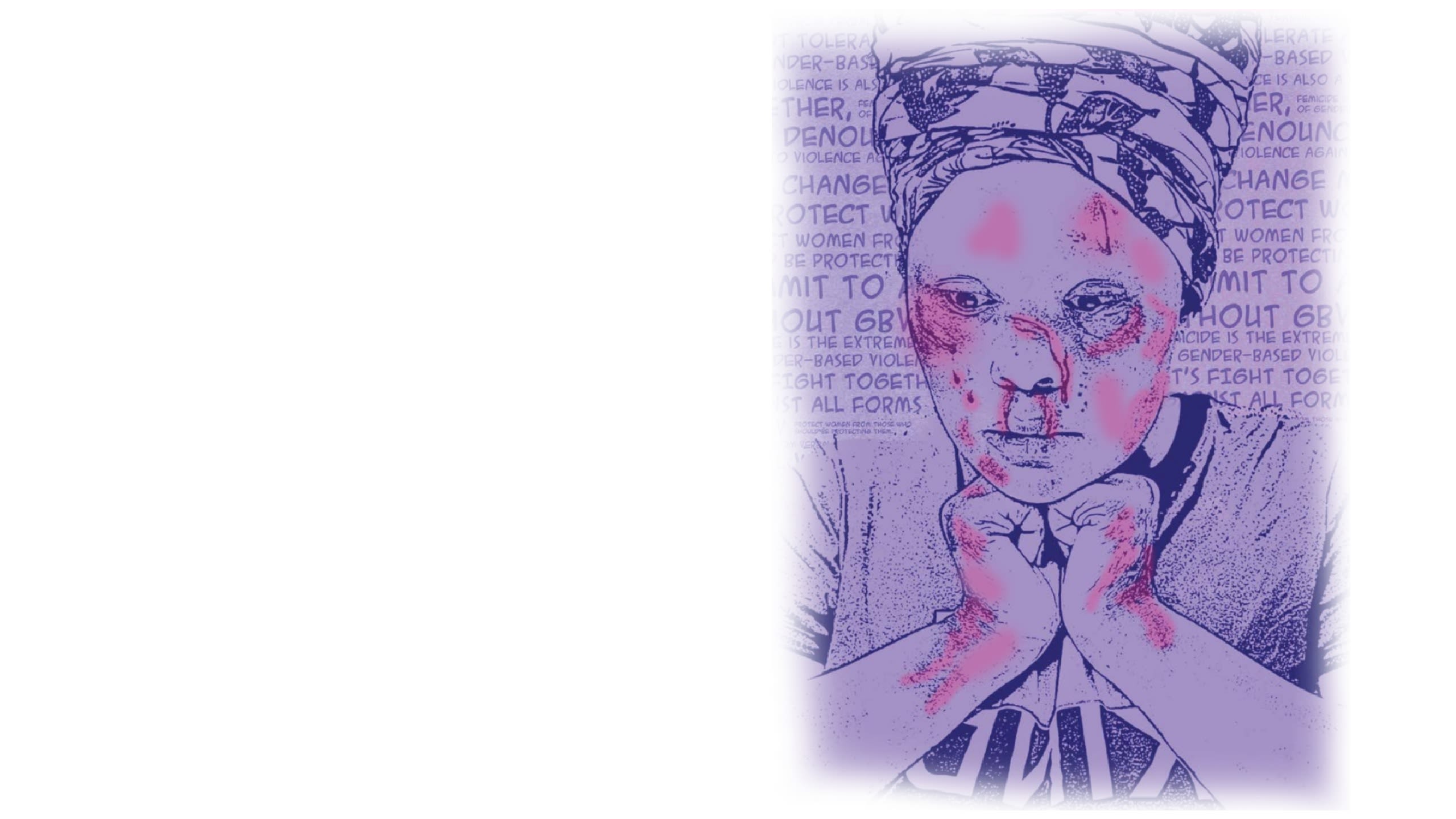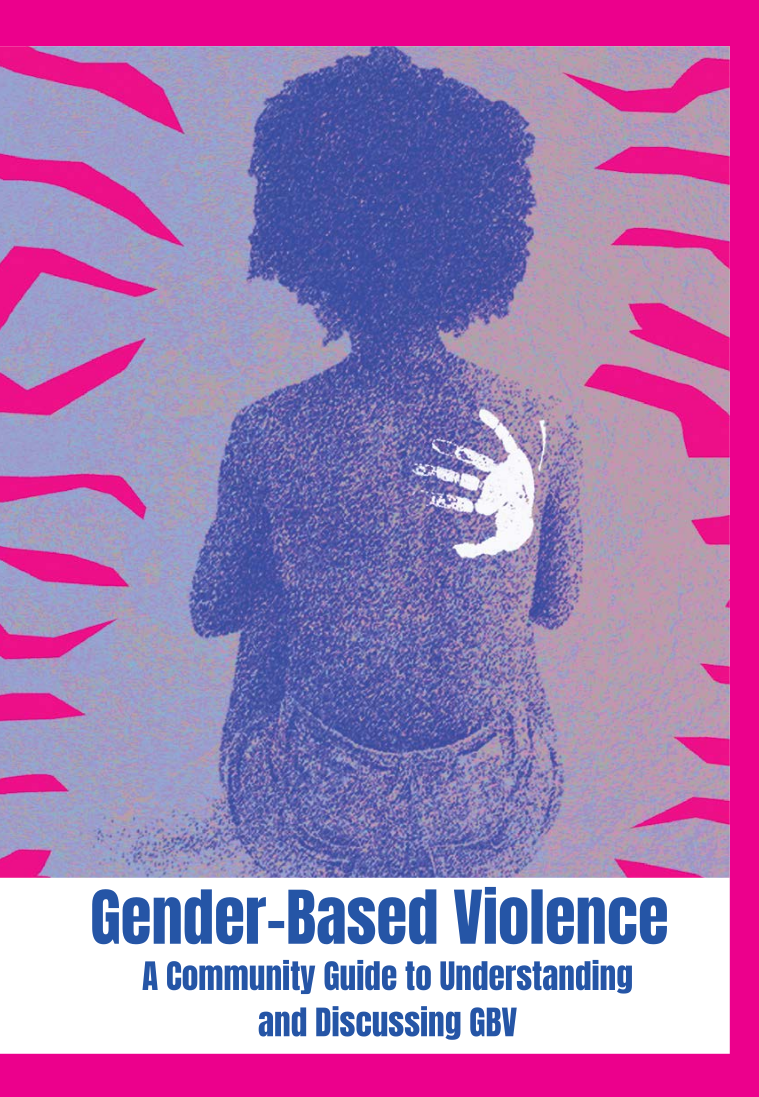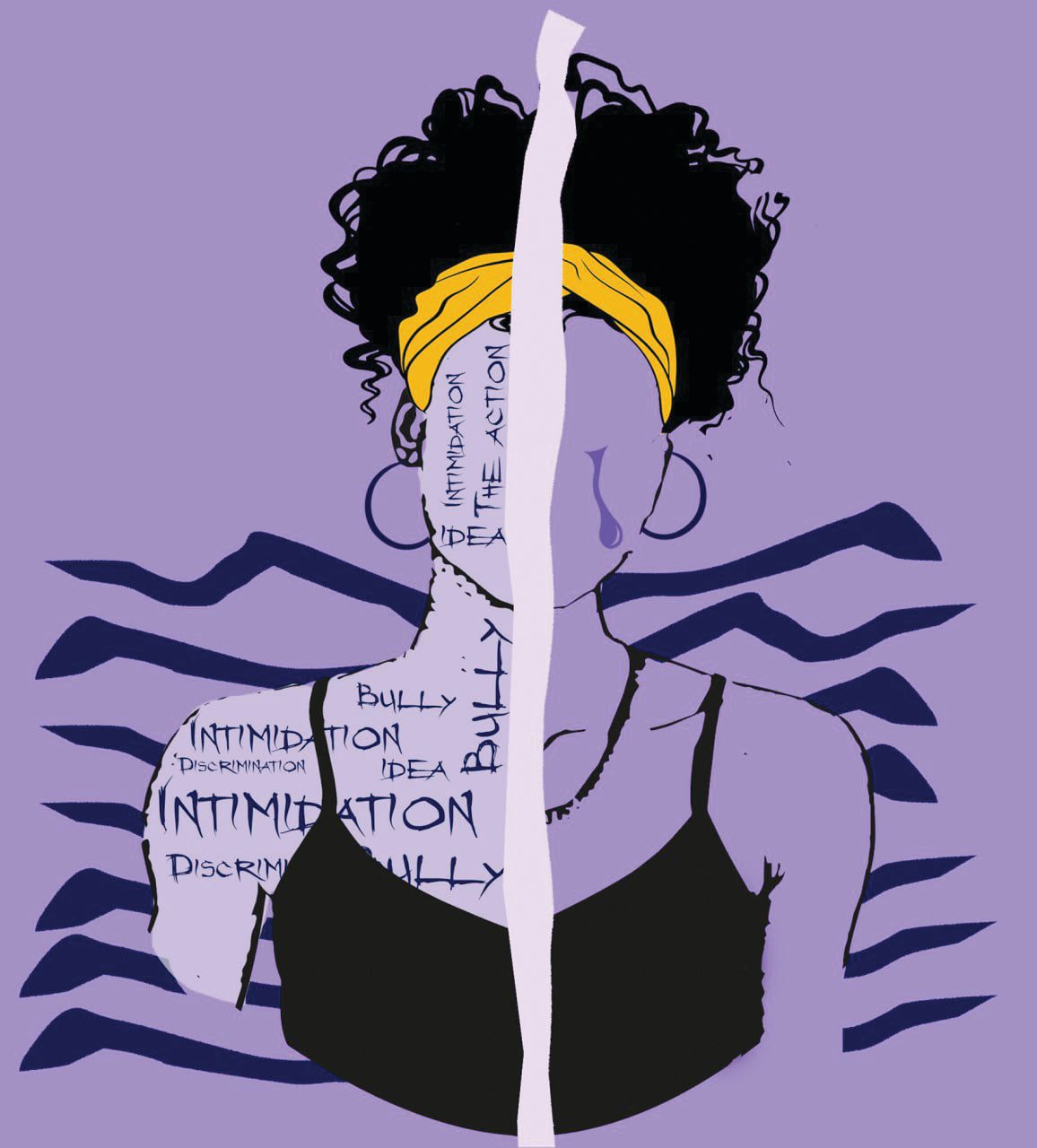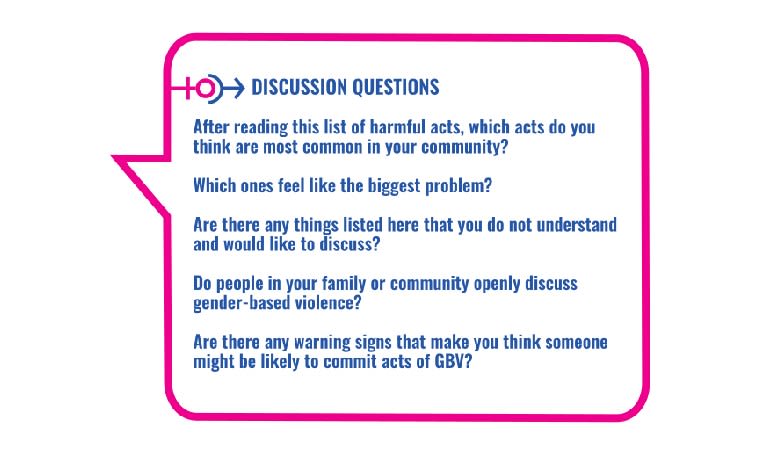Gender-Based Violence
A Community Guide to Understanding and Discussing GBV

https://defyhatenow.org
[email protected]
©2024 r0g_agency for open culture and critical transformation gGmbH, Berlin
Concept: r0g_agency gGmbH, Berlin,
Stephen Kovats & Susanne Bellinghausen
GBV Guide Authors + Editors: Sara Budarz & Kendi Gikunda
Cameroon Country Manager: Ngala Desmond Ngala
GBV Guide Contextual Editorial Consultants: Dr. Kinang Derick Fai, Dr. Sally Mboumien, Aissa Doumara, Merolyn Yafe, Barrister Dorcas Nkongme, Dr. Christine Abonge, Vivian Tathi, Angaama Joy, Banga Indira, Melvin Songwe, Penka Marthe Bogne, Eunice Tita Tata, Myriamme Chimene, Caroline Mveng, Renée Nwoes, Dr. Eileen Akwo.
GBV Guide Design and Layout: Heike Bluthardt
GBV Guide Illustrations: Felix Bwamou
This Gender Based Violence Guide is a module of the #defyhatenow Social Media Hate Speech Mitigation Field Guide which is licensed under a Creative Commons Attribution-ShareAlike 4.0 International CC BY-SA 4.0 license
Introduction
At #defyhatenow our mission is to work against hate and
incitement to violence, in all of its forms. We take a community-
based approach to peacebuilding and work on spreading skills and knowledge by having locals conduct trainings within communities.The goal is to strengthen and amplify the voices of peace.
While many forms of hate and violence are easy to identify -
violence that erupts on the streets, for example - there are also
forms of violence that are often overlooked or seen as normal.
One form of violence that is often overlooked is violence towards
women and girls. We call this gender-based violence.
In this guide, we will focus on addressing gender-based violence,
often shortened to GBV.
We will discuss:
- what gender-based violence is,
- how gender-based violence shows up in all aspects of life,
- how to discuss GBV in your community, and
- what steps can be taken to stand up to this form of violence.
The goal of this guide is to increase awareness, educate, facilitate
discussions, and empower everyone within the community to work towards creating a safer and more equitable society.
This guide can be used by individuals to read on their own or it can be used as a tool to host workshops and discussions.
What is gender-based violence (GBV)?
Let’s start with a simple definition: gender-based violence is
violence directed at someone primarily because of their gender.
Both men and women can experience gender-based violence, but
most often when we talk about gender-based violence, we are
talking about violence that specifically targets women and girls.
Violence towards men, boys, and people whose behavior does not
conform to gendered expectations also exist. Yet statistically, if we look at data collected by organizations such as the United Nations and the World Health Organization, women and girls are the ones most often victimized.
GBV encompasses a wide range of harmful behaviors and actions
that are rooted in gender inequality and the misuse of power. GBV happens because people see women and children as having less
value, a lower standing, or less power than their male counterparts.
Because GBV is based on an imbalance of power between men
and women, gender-based violence is more common in societies
in which men hold vastly more power than women in the home,
the community, and society as a whole. It is also more common
in families in which men see themselves as the head of the
households. This is especially true in most African families, where
traditional gender roles are enacted.
There are many benefits to society when we start moving towards
having men and women share in power, both within the home and within all institutions and aspects of society. One of the big benefits is that when this happens, rates of violence go down. Life becomes safer for everyone.
Prevalence of GBV
Gender-based violence can occur in any setting, including in homes, in public, in the workplace, in schools, within the community, and online. But the most common place gender-based violence takes place is within families.
GBV is a pervasive and widespread issue that affects millions of individuals worldwide. The World Health Organization (WHO) estimates that 1 in 3 women experience sexual violence in their lifetime. For Sub-Saharan Africa, the rates are even higher.
Yet because gender-based violence is often not reported, it is incredibly difficult to have accurate statistics.
Why is GBV often not reported? The most simple reason is that society discourages women from reporting it. GBV that takes place within the family is often seen as a private matter and so is not reported. The trauma and shame associated with violence also makes it hard to talk about and harder to report. There is the fear that reporting violence will lead to more violence or put the person reporting it into danger. And sadly, police and the judicial system often fail women, not taking their reports seriously.
When social scientists compare the level of violence that can be observed in communities with how infrequently these crimes are officially reported, they can make educated guesses about the actual levels of violence against women and children. The conclusion? We can assume that most or all women will experience some form of gender-based violence in their lifetime. This makes gender-based violence a large-scale human rights violation. If half of the population is female, that means that at least half of the world’s population will experience gender-based violence.
This needs to change.

Summary
Gender-based violence is violence towards women and girls that
can happen anywhere, often happens among people who are
related, and is based, among other factors, on the faulty belief
that women and children are of lesser value. It is a misuse of
power
Forms of GBV
Gender-based violence is divided into categories to show the many different forms GBV can take. But it is important to note that one act of gender-based violence will often include many different categories of violence.
For example, rape is included primarily as sexual violence in the list below, but rape also includes elements of physical violence (being pushed or hit or restrained) and psychological violence (both during and afterward the trauma).
Gender-based violence exists along a continuum from more minor acts, such as name-calling, to the most extreme form of GBV: femicide.
As the UN Women website states, “gender related killings (femicide/feminicide) are the most brutal and extreme manifestation of a continuum of violence against women and girls that takes many interconnected and overlapping forms. Defined as an intentional killing with a gender-related motivation, femicide may be driven by stereotyped gender roles, discrimination towards women and girls, unequal power relations between women and men, or harmful social norms.”
These killings of women are particularly troubling not only for the loss of life, but for the dehumanizing way societies often talk about the deaths, often blaming the victims for the outcome. Instead, we need to understand that femicide is deeply rooted in inequality and that all women, regardless of any actions they take or do not take, deserve to live life free of the threat of violence or death.
It is also important to note that most often, femicide is committed by men close to the women, whether family members or intimate partners. This is particularly troublesome because it means that those closest to women are also the most likely to hurt or kill them. The people who should provide a safe refuge from the world are actually, statistically, the most dangerous.
Along the continuum of gender-based violence, we often divide GBV into these categories:
Physical violence
such as being hit, slapped, pushed, beaten, or murdered.
Sexual violence
such as unwanted touching, sexual harrassment, rape, forced prostitution, and other forms of sexual assault. Sexual violence often exists alongside other forms of violence, such as physical and psychological violence.
Traditional Practices
can also be forms of gender-based violence when they cause physical or psychological harm, such as female genital mutilation/cutting (FGM/C), breast ironing, child marriage, forced marriages, dowry-related violence, and honor killings
Political Silencing
is a form of gender-based violence when women who are in positions of power or politics are attacked, often online, with threats of violence, harassment, sexually derogatory statements, and an assault on their character and bodies.
Psychological violence
also known as Emotional Violence, is non- physical violence that aims to inflict emotional harm, such as verbal threats, insults, intimidation, humiliation, controlling behaviors, and gaslighting (which is where a person causes you to question your own sanity, memories, or perception of reality).
Online Violence
also called Technology-Facilitated Violence, is included in gender-based violence when the violence targets women and girls online and through technology such as messaging apps. Examples include online harassment, slander, cyberbullying, stalking, threats, and revenge porn.
Economic violence
also known as Denial of Resources, such as destroying property, depriving someone of access to financial resources, controlling money, or not allowing women to access education. Economic violence is a way to limit women’s abilities to control their own life and livelihoods and thereby force them to be dependent on others.
Summary
Gender-based violence includes acts such as rape, sexual assault, forced marriages, and silencing. We often divide GBV into physical, sexual, psychological, economic, and online harm. Many traditional practices that harm a body or dictate who we have to marry are also a form of gender-based violence.
Gender-based violence in the home
The first step towards change is being aware of gender-based violence and being able to name the different forms of violence. That is what we just learned in the section above.
The next step is being aware of where you are most likely to experience gender-based violence: at home.
Domestic violence is the most common form of gender-based violence. Domestic violence can include violence between a couple, but also include violence between other members of the family. Often, for example, a father or uncle might be inflicting harm upon their daughter or other child in the family. But violence between a husband and wife is the most common form of domestic violence.
There are many reasons why domestic violence is the most common form. For one thing, it is the place where we spend the majority of our time. It is also the place where violence can happen and yet not be talked about, because it is incredibly hard to discuss violence when it is happening at home. Violence at home also often begins slowly, with an insult or demeaning language, and slowly moves up to physical violence and sexual violence. For a long time, societies were slow to label violence in the home as violence.
For example, some countries still do not recognize the existence of rape within a marriage as a possibility, even thought any nonconsentual sex is rape, regardless of whether the aggressor is a stranger or your husband.
Likewise, verbal threats, any physical harm inflicted, control of resources, and gaslighting are all forms of domestic violence. And yet in many places, these harms are seen as normal.
Normalizing domestic violence allows the cycle of violence to continue and spread, from generation to generation. Learning to name domestic violence and understanding it as part of gender-based violence helps us see that being unsafe at home is never acceptable. All women and children deserve to be safe and at ease at home.
It is important to note that gender-based violence can affect any woman, but gender intersects with other categories of identity that make violence even more likely to occur, including social class, sexual orientation, religion, (dis)ability, and so on. External facts, such as poverty and being in conflict situations, are also extremely dangerous for women and children.
What this means is that anyone can become the victim of domestic violence, but especially those who are struggling to support their families and find employment are especially vulnerable.
A big problem is that friends and family often downplay the problem when women do speak up. Or they are told that for the sake of the children, they have to make that abusive relationship work. Sometimes they are even blamed for the violence - even by other women. Or are given quotes from religious texts that are taken out of context and appear to support a man’s right to beat his woman.
In other words, women are often blamed for the violence they experience and often there is a lack of support. This needs to change - and it starts with each of us learning to react differently when confronted with stories of violence in the home.



Discussion Questions
- What does it mean for you to feel safe at home?
- Do you feel that forms of violence, such as pushing or slapping, are normal within your communities or at home?
- Why do you think we so often blame the women or try to convince them to stay in situations in which they are being harmed?
- We know it is hard to talk about domestic violence at home because it means saying bad things about our family and many women were taught to protect their family's reputation no matter what. Also, we don't always know who to talk to. Even so - can you think of someone you feel safe talking to?
- What is the connection between being able to label something as domestic violence and starting to advocate for change?








